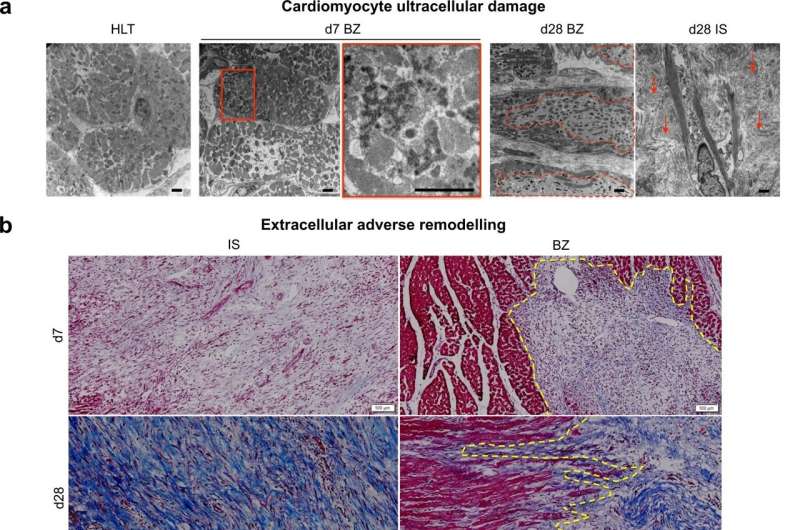This article has been reviewed according to Science X's editorial process and policies. Editors have highlighted the following attributes while ensuring the content's credibility:
fact-checked
peer-reviewed publication
trusted source
proofread
Researchers investigate pre-clinical model for clinically relevant treatments for heart attacks

CÚRAM SFI Research Centre for Medical Devices researchers have published in Nature Communications a key study establishing a new pre-clinical model to develop clinically relevant treatments for heart attacks.
Heart attacks (myocardial infarction (MI)) occur due to an acute complication of coronary artery disease and are a major cause of global mortality. The two main types of heart attack are ST-elevation (STEMI) and Non-ST elevation (NSTEMI). A non-ST-elevation is a type of heart attack that usually happens when your heart's oxygen needs are unmet. This condition gets its name because it doesn't have an easily identifiable electrical pattern like with an ST elevation that can be read from an electrocardiogram (ECG).
Patients who survive a heart attack have variable degrees of damage to their cardiac tissue, which can lead to heart failure in a significant proportion of these patients. In the last two decades, NSTEMIs have markedly risen in hospitalized patients. This subtype of heart attack results in a smaller amount of tissue damage compared to STEMIs. Still, importantly, recent clinical registry data shows that NSTEMIs are associated with higher long-term mortality than STEMIs.
Currently, preclinical models of heart attack mimic only full-thickness STEMI and hence cater only for an investigation into therapeutics and interventions directed at the NSTEMI subset of heart attack.
In this new study, researchers have developed a preclinical model of NSTEMI by adopting a novel surgical procedure that closely resembles the complexity of clinical cases in humans. Researchers validated the presented model by comparing it with an established method to achieve STEMIs. They performed a detailed analysis at the main acute and late time points after the induction of NSTEMI, at 7 and 28 days, respectively.
Dr. Paolo Contessotto and Dr. Renza Spelat said, "Advanced analyses on the affected heart tissue highlighted a distinctive pattern of alterations in the tissue, especially in the sugar moieties (glycans) which compose cardiac cell membranes and extracellular matrix (the network of proteins and other molecules that surround, support, and give structure to cells and tissues in the body). Identifying such changes in molecular elements that can be accessed and treated with injectable drugs sheds light on how we can develop targeted pharmacological solutions to correct these changes."
This research resulted from an established collaboration of CÚRAM with European institutions in Italy (University of Milano-Bicocca), France (University of Paris Est Créteil), Sweden (University of Gothenburg) and Lithuania (Lithuanian University of Health Sciences).
Professor Abhay Pandit, CÚRAM Scientific Director and senior author of the study, said, "There is a need in the field to adopt clinically relevant models to study NSTEMI pathophysiology and reveal its functional differences with STEMI induction. This new model will facilitate the translation of future research in the field, enabling the discovery of new clinically relevant treatments for patients."
Mr. Mark Da Costa, Clinical Investigator at CÚRAM and senior author of the study, said, "Currently, NSTEMI is the most common presentation of acute heart attack. The concern is that NSTEMI patients have lower in-patient (during their admission for the primary NSTEMI) and short-term mortality rates but significantly higher long-term mortality than those of STEMI patients. A Danish registry study of 8,889 patients showed that the 5-year mortality after NSTEMI was 16%, and another registry study highlighted a 10-year survival rate of only around 50%. To the best of our knowledge, there are currently no models that can reproduce both the functional and histological characteristics of NSTEMIs. This novel model may specifically serve as a preclinical foundation to study interventions that could combat the short and long-term effects of NSTEMI."
More information: Paolo Contessotto et al, Reproducing extracellular matrix adverse remodelling of non-ST myocardial infarction in a large animal model, Nature Communications (2023). DOI: 10.1038/s41467-023-36350-1



















